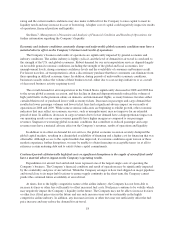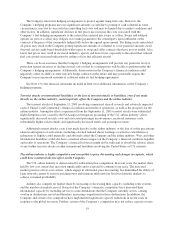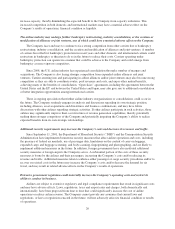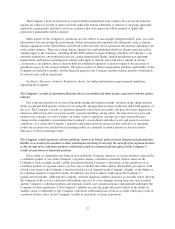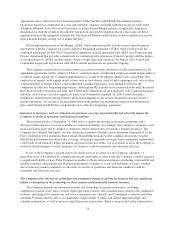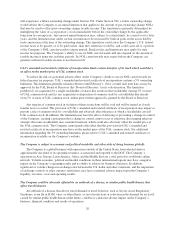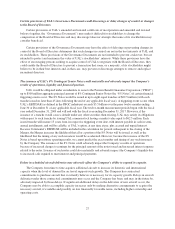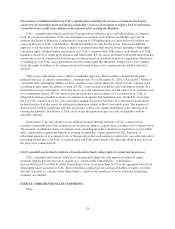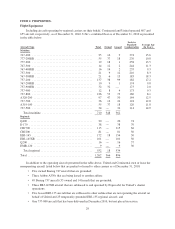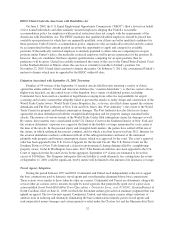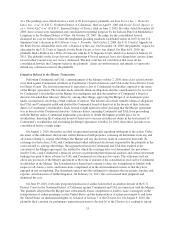United Airlines 2010 Annual Report Download - page 27
Download and view the complete annual report
Please find page 27 of the 2010 United Airlines annual report below. You can navigate through the pages in the report by either clicking on the pages listed below, or by using the keyword search tool below to find specific information within the annual report.repeated disruptions due to events beyond the Company’s control, including natural disasters, power failures,
terrorist attacks, equipment or software failures, computer viruses or hackers. Substantial or repeated website,
reservations systems or telecommunication systems failures could reduce the attractiveness of the Company’s
services versus its competitors, materially impair its ability to market its services and operate its flights, and
could result in increased costs, lost revenue and the loss or compromise of important data.
The Company’s business relies extensively on third-party providers. Failure of these parties to perform as
expected, or interruptions in the Company’s relationships with these providers or their provision of services to
the Company, could have an adverse effect on the Company’s financial position and results of operations.
The Company has engaged an increasing number of third-party service providers to perform a large number
of functions that are integral to its business, including regional operations, operation of customer service call
centers, distribution and sale of airline seat inventory, provision of information technology infrastructure and
services, provision of aircraft maintenance and repairs, provision of various utilities and performance of aircraft
fueling operations, among other vital functions and services. The Company does not directly control these third-
party providers, although it does enter into agreements with many of them that define expected service
performance. Any of these third-party providers, however, may materially fail to meet their service performance
commitments to the Company or agreements with such providers may be terminated. For example, flight
reservations booked by customers and travel agents via third-party GDSs may be affected by changes to the
contract terms between the Company and GDS operators. A failure to agree upon acceptable contract terms when
these contracts expire or otherwise become subject to renegotiation, which is scheduled to occur for some of
these contracts later in 2011, or other disruptions in the business relationships between the Company and GDS
operators, may cause the carriers’ flight information to be limited or unavailable for display, significantly
increase fees for both the Company and GDS users, and impair the Company’s relationships with its customers
and travel agents. The failure of any of the Company’s third-party service providers to adequately perform their
service obligations, or other interruptions of services, may reduce the Company’s revenues and increase its
expenses or prevent the Company from operating its flights and providing other services to its customers. In
addition, the Company’s business and financial performance could be materially harmed if its customers believe
that its services are unreliable or unsatisfactory.
The Company’s ability to use its net operating loss carryforwards to offset future taxable income for U.S.
federal income tax purposes may be significantly limited due to various circumstances, including certain
possible future transactions involving the sale or issuance of UAL common stock, or if taxable income does
not reach sufficient levels.
As of December 31, 2010, UAL reported consolidated federal net operating loss (“NOL”) carryforwards of
approximately $11.6 billion.
The Company’s ability to use its NOL carryforwards may be limited if it experiences an “ownership
change” as defined in Section 382 of the Internal Revenue Code of 1986, as amended (“Section 382”). An
ownership change generally occurs if certain stockholders increase their aggregate percentage ownership of a
corporation’s stock by more than 50 percentage points over their lowest percentage ownership at any time during
the testing period, which is generally the three-year period preceding any potential ownership change.
As of October 1, 2010, UAL Corporation and Continental each experienced an ownership change under
Section 382 in connection with the Merger. While these merger-related ownership changes are not expected to
significantly limit the Company’s use of its NOL carryforwards in the carryforward period, there is no
assurance that the Company will not experience a future ownership change under Section 382 that may
significantly limit or possibly eliminate its ability to use its NOL carryforwards. Potential future transactions
involving the sale or issuance of UAL common stock, including the exercise of conversion options under the
terms of the Company’s convertible debt, repurchase of such debt with UAL common stock, issuance of UAL
common stock for cash and the acquisition or disposition of such stock by a stockholder owning 5% or more
of UAL common stock, or a combination of such transactions, may increase the possibility that the Company
25





